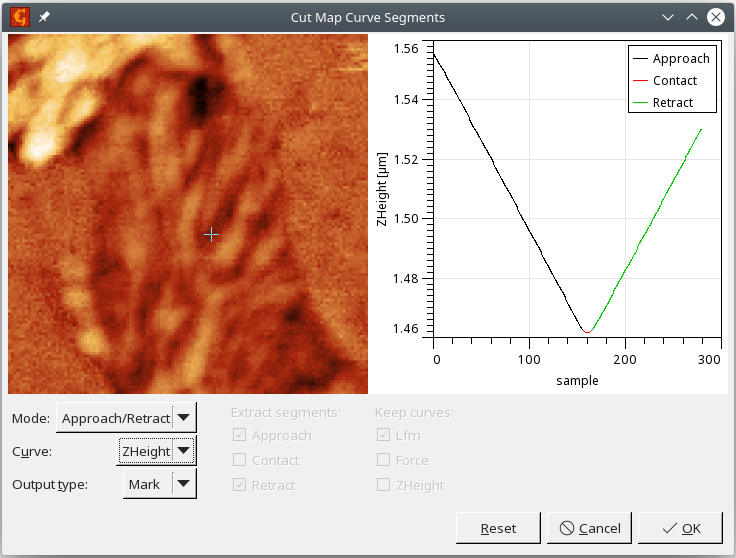Curve maps are formed by bundles of curves measured on a regular grid, so the data processing tasks are either connected to extracting the individual curve data, or to automatically processing the curves in every point to create a map of some evaluated quantity.
Basic curve map operations include simple tasks available as a set of menu entries → . This includes functions for cropping, flipping, rotating curve maps, as well as for changing their physical scale, having the same meaning as for the 2D data. Such functions are useful for any type of curve maps. In contrast to this, many functions are suitable only for some particular curve map types, namely for maps of force-distance curves that many SPMs can produce.
Note that at present the curve map functions typically do not store undo data as the size of a typical curve map is already very large.
→ →
The module cuts the curve map in lateral directions that can be entered either in pixels or in physical dimensions. With Keep lateral offsets option enabled, the top left corner coordinates of the resulting image correspond to the top left corner of the selection, otherwise the top left corner coordinates are set to (0, 0).
Flip the data horizontally (i.e. about the vertical axis), vertically (i.e. about the horizontal axis) or in both axes with → → , or , respectively.
→ →
The module changes physical dimensions of curve maps. This is useful for the correction of raw data that have been imported with wrong physical scales or as a simple manual recalibration of dimensions and values. Apart of different methods for determining the scaling factors (matching pixel size of another data set, setting the scale directly or setting the physical dimensions), the module can be also used to set the lateral offsets. Finally, it can be also used to set the lateral scale units if this was not done while loading the file.
→ →
The module removes any curve map segmentation. Segments are formed by marks on datasets in each pixel of the curve map and can be used e.g. for splitting the force-distance curve into an approach and a retract part in the force-distance data processing modules. Using this module all such marks are deleted.
→
The module performs alignment of the curves in the 'z' direction, where 'z' can mean height, but also any other variable on which the spectra are dependent, like voltage in a IV characteristics. A typical use is aligning the Force-Distance curves measured on a sample with large topography variations, obtaining the topography and shifting all the curves to start at the same z level.
→
The module extracts individual curves as a graph, displayed in the graph window. As there is no hierarchy in the data forming the curve map, it is necessary to select Abscissa (the independent variable) and Ordinate (the dependent variable) to do so. Typically, for a force-distance curve, the Abscissa will be something related to height or probe-sample separation and Ordinate will be something related to force. Multiple curves can be extracted by clicking on the Extract Multiple option.
→
The module can be used to either create segments on the curve map or to extract these segments. Segments are the key prerequisite for some of the curve map analysis functions. For example, they can represent the approach and retract part of force-distance data. The module uses a Curve selected by the user and applies some method (selected by Mode parameter) to detect how to split (or mark) the data. For the mentioned case of force-distance measurements the most logical split would be based on the height, segmenting the curve to an approach, hold and retract part as shown here.

Screenshot of Cut to Segments module, showing typical segmentation settings for force-distance data.
The Output type can be set to mark the segments only, which is the most typical application. Here, the curve map is not altered, only positions of segments for each individual pixel are added. This is the mode which should be selected to prepare data for curve map processing modules that use segmented data. The second option is to extract some segments, including the selection of which curves should be kept. This can be also used to shrink the data size significantly, keeping only what is needed.






